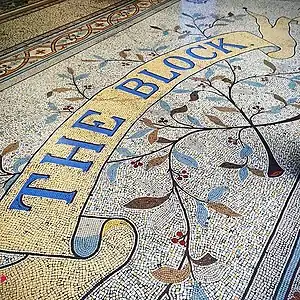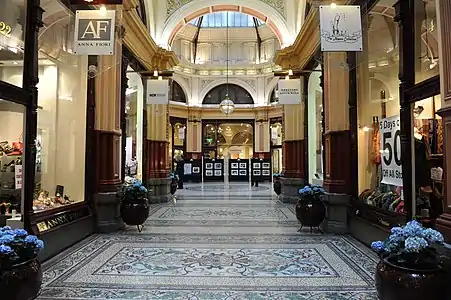  From top: Block Arcade looking south, Collins Street façade | |
| Location | Victoria, Australia |
|---|---|
| Coordinates | 37°48′57″S 144°57′52″E / 37.81583°S 144.96444°E |
| Address | 282 Collins Street, Melbourne |
| Opening date | 1892 |
| Management | Allard Shelton Pty Ltd |
| Owner | Block Arcade Melbourne Pty Ltd |
| No. of floors | 5 |
| Website | theblock |
The Block Arcade is an historic shopping arcade in the central business district of Melbourne, Victoria, Australia.[1] Constructed between 1891 and 1893, it is considered one of the late Victorian era's finest shopping arcades and ranks among Melbourne's most popular tourist attractions.
Designed by architects Twentyman & Askew, the Block is one of Melbourne's most richly decorated interior spaces, replete with mosaic tiled flooring, glass canopy supported in cast and wrought iron, and tall, elaborate timber shop fronts. The arcade is L-shaped with an octagonal rotunda at the corner, connecting Collins Street at the south end to Elizabeth Street on the west. On the north side, the arcade connects to Block Place, a covered pedestrian lane that leads to Little Collins Street, opposite Melbourne's oldest shopping arcade, the Royal Arcade. The Block Arcade's six-storey external façades on both Collins and Elizabeth streets are some of Australia's best surviving examples of Victorian architecture in the Mannerist style.
The arcade takes its name from the practice of "doing the block": dressing fashionably and promenading the section of Collins Street between Elizabeth and Swanston streets. It is listed on the Victorian Heritage Register.[1]
Name: "doing the block"

By the late 1870s, the north side of Collins Street between Swanston and Elizabeth streets had become the favoured promenade of Melbourne's well-to-do, who went there to frequent its prestigious shops and cafes, and to see and be seen as they walked from one end to the other. This practice became known as "doing the block".[2]
Author Fergus Hume described "doing the block" in his novel The Mystery of a Hansom Cab, first published in Melbourne in 1886:
It was Saturday morning and fashionable Melbourne was 'doing the block'. Collins Street is to the Southern city what Bond Street and the Row are to London, and the Boulevards to Paris... Carriages were bowling smoothly along, their occupants smiling and bowing as they recognized their friends on the side walk... Portly merchants, forgetting Flinders Lane and incoming ships, walked beside pretty daughters; and the representatives of swelldom were stalking along in their customary apparel of curly brimmed hats, high collars and immaculate suits. Altogether it was a pleasant and animated scene...
History
The site

On 1 June 1837, the first auctions of blocks in what is now the Melbourne CBD took place. The block now occupied by the Collins Street portion of the arcade was purchased by William Briscoe & Son. The Briscoes Bulk Grain Store occupied the site from 1856 to 1883, building a large new premises in 1877.[3]
In 1883, the building was sold to the George brothers' George & George Federal Emporium, established in 1880 a few doors up, who refurbished the interior for their expanding drapery business[4] (which would eventually become Georges Store). Financier and landboomer Benjamin Fink was a director of the company, and by 1888 had plans to relocate the store and create an L-shaped arcade in the area, and began buying up properties.[5][6] In 1888 Fink bought the Equitable Co-operative store at 162 Collins Street, and made it a branch of George’s.
Construction
At 6:15 pm on Friday 13 September 1889, a huge fire gutted the Georges Emporium, causing over AU$400,00 worth of damage, and accelerating Finks plans, with George’s consolidated at the new site.
The fire occurred at the height of the land boom of the 1880s, when Melbourne grew enormously and many large and elaborate hotels shops and office blocks rose in the city. The fire allowed the City Property & Co Pty Ltd (principal shareholder Benjamin Fink) to proceed with plans to create a sumptuous arcade on this central site, hiring architects Twentyman & Askew to design it, announced in January 1890,[7] with the name 'The Block' revealed soon after.[8] The Collins Street leg was built first, which was completed by late 1891,[9] to little fanfare, with the grand opening of the whole arcade on 7 October 1893.[10]
The Collins Street leg has an angled kink because the site narrows part way up due to the presence of a narrow laneway on the west side. Originally known as Carpenters Lane, the City Property Co successfully petitioned to roof it, creating a covered access from the Block Arcade to Little Collins Street. This in turn led to the development of shops in the lane, which was soon renamed Block Place.[11] In 1902, Royal Arcade, which has been a dead end, was opened through to Little Collins Street creating a covered walk from Collins right through to Bourke Street.
The design is often said to have been inspired by the 1870s Galleria Vittorio in Milan, which has a similar domed crossing, but on a much vaster scale.[12][13]
Ownership changes
In the 1986, the arcade was purchased by the Time Corporation for AU$15 million.[14] By 1991, Westpac took over the mortgage and sold the building to the Kearney family in 1993 at public auction.[15] The Kearneys undertook extensive refurbishment, repairing the mosaic floors, repainting the interior in heritage colours, and renovating the office spaces above.
In 2014, the Cohen family purchased the Block Arcade. The Cohen family have had long ties with Melbourne which date back to the 1840s, when Trevor Cohen's great great grandfather struck one of the first leases in Melbourne, for the ground floor of the nearby 'Cashmore's Corner' on the northeast corner of Collins and Elizabeth Streets, and where his great grandmother was born. The Cohens are passionate about the precinct, and continue to maintain the Block Arcade to its former glory with an eye for detail.[16]
Block Court

The building adjacent to the Block Arcade at 288-292 Collins Street was built in 1890 as the Athenaeum Club, and in 1930 the ground floor was converted into an arcade, designed by noted architect Harry Norris, one of the earliest and most elaborate Art Deco interiors in Melbourne.[17] This arcade originally connected through to the Block Arcade with the removal of one of the shopfronts in the Elizabeth Street wing. At some point this building was bought by the owners of the Block Arcade, and they are still in the same ownership. In the 1990s, as part of the restoration of the Block Arcade, the shop was reinstated, and the north end of the Block Court arcade was closed off, and the shopfronts removed to create a large area shop. In 2016, the Block Court Arcade was partially restored, reinstating the shopfronts, but as counters for a branch of the Bendigo Bank, with access through the rear to a laneway and then into the Block Arcade.[18]
Notable shops

The Hopetoun Tea Rooms opened in 1894, established by 'society girl' Miss Chrissie Robertson, 'daintily appointed' and intended for her society friends who did not wish to patronise ordinary tea rooms.[19][20] Moving to the current rooms in 1907, it was redecorated in 1976 in Victorian style, with emerald and black wallpaper, and velvet ceiling hangings, designed by interior designer Murray Sheldrick.[21][22] The Hopetoun Tea Rooms are sometimes confused with the tea room located in the rotunda of the Ladies Work Association, a charity for upper class women who had fallen on hard times, which operated from 1891-c1900, and whose patron was Lady Hopetoun.[23]
The Singer Sewing Machine Company moved into the shop on the eastern side of the Collins Street entrance in 1902, where it remained for many years. The shop was popular with female patrons, and sewing classes were run in the basement. Phillip Goatcher, scenic artist, was commissioned to paint an elaborate mural on the ceiling, still in place.[24]
In the shop to the left of the Collins Street entrance, the Block Arcade also housed the first Kodak store in Melbourne, the camera company from Rochester, New York. Kodak allowed the average person to take photographs and promoted the arts of photography to the general public. The store sold parts, cameras, and equipment to both amateurs and professionals, and has an elaborate pressed metal ceiling.[25]
Gallery
 Detail of the mosaic tile floor
Detail of the mosaic tile floor.jpg.webp) Decorative arches
Decorative arches Clock
Clock Collins Street leg
Collins Street leg Central rotunda
Central rotunda
See also
References
- 1 2 "Block Arcade, Victorian Heritage Register (VHR) Number H0032, Heritage Overlay HO596". Victorian Heritage Database. Heritage Victoria.
- ↑ School of Historical Studies, Department of History. "Doing the Block - Entry - eMelbourne - The Encyclopedia of Melbourne Online". www.emelbourne.net.au. Retrieved 23 June 2020.
- ↑ "THE NEW WAREHOUSES OF MESSRS. BRISCOE AND CO., COLLINS—STREET EAST". Australasian Sketcher with Pen and Pencil (Melbourne, Vic. : 1873 - 1889). 1 September 1877. p. 93. Retrieved 23 June 2020.
- ↑ "A NEW ENTERPRISE. - The Age (Melbourne, Vic. : 1854 - 1954) - 11 Sep 1883". Trove. Retrieved 23 June 2020.
- ↑ "CURRENT NOTES". Melbourne Punch (Vic. : 1855 - 1900). 12 April 1888. p. 1. Retrieved 23 June 2020.
- ↑ "A Romance of Finance". Table Talk (Melbourne, Vic. : 1885 - 1939). 14 October 1892. p. 5. Retrieved 23 June 2020.
- ↑ The City Property Company's New Arcade The Age 28 January 1890
- ↑ "A New Arcade". The Age. 24 March 1891. p. 5. Retrieved 23 June 2020.
- ↑ "A NEW MUSIC WAREHOUSE". Australasian. 28 November 1891. p. 24. Retrieved 23 June 2020.
- ↑ "THE TOWN". Leader (Melbourne, Vic. : 1862 - 1918, 1935). 7 October 1893. p. 25. Retrieved 23 June 2020.
- ↑ School of Historical Studies, Department of History. "Block Place - Entry - eMelbourne - The Encyclopedia of Melbourne Online". www.emelbourne.net.au. Retrieved 26 June 2020.
- ↑ "PUBLIC. HOUSE OR CAFE?". Herald (Melbourne, Vic. : 1861 - 1954). 27 August 1906. p. 3. Retrieved 23 June 2020.
- ↑ In 2003, the City of Melbourne signed a sister city agreement with the City of Milan, perhaps inspired by the connection between the Block Arcade and the Galleria.
- ↑ "Block Arcade". eMelbourne - The Encyclopedia of Melbourne Online. Retrieved 23 June 2020.
- ↑ "Melbourne's historic shopping precinct, Block Arcade, up for sale listl". ABC News. Retrieved 25 July 2016.
- ↑ "Block Arcade owner unveils surprises under the dome listl". The Age. Retrieved 25 July 2016.
- ↑ "Block Court Arcade". vhd.heritagecouncil.vic.gov.au. Retrieved 23 June 2020.
- ↑ "More foot traffic than an AFL final lures Bendigo Bank to Cohen's Block". Australian Financial Review. 17 February 2016. Retrieved 23 June 2020.
- ↑ "gossip". Melbourne Punch (Vic. : 1855 - 1900). 12 July 1894. p. 27. Retrieved 28 May 2020.
- ↑ Most online sources state that it was bought for £18, opened concurrently with the opening of the Block Arcade in 1892, established by the Victorian Ladies' Work Association charity, and named in honour of Lady Hopetoun, wife of Lord Hopetoun, Victorian Governor (1889–1895). However that was a smaller tea room that was part of the societies rooms and activities, named after them, rather than Lady Hopetoun.
- ↑ "The Age". August 1976.
- ↑ "Block Arcade". Victorian Heritage Database. Retrieved 28 May 2020.
- ↑ School of Historical Studies, Department of History. "Hopetoun Tea Rooms - Entry - eMelbourne - The Encyclopedia of Melbourne Online". www.emelbourne.net.au. Retrieved 23 June 2020.
- ↑ "Block Arcade listl". Melbourne Heritage. Retrieved 25 July 2016.
- ↑ "Photograph - Kodak, Building Exterior, Block Arcade, Melbourne, circa 1908 listl". Museum Victoria Collections. Retrieved 25 July 2016.